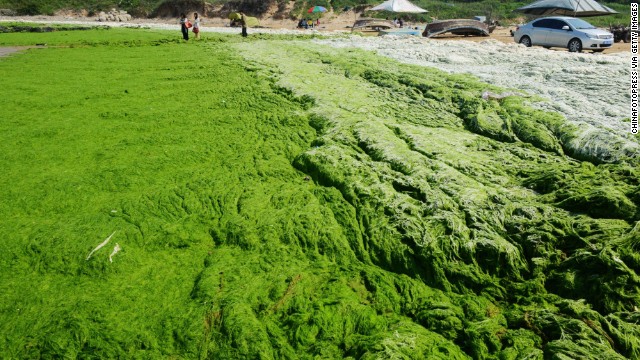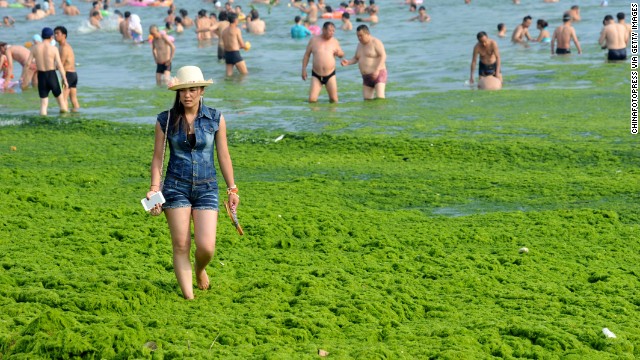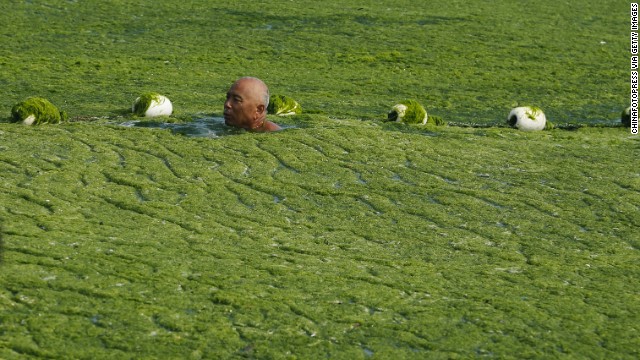- Back to Home »
- Green blob covers Chinese waters
 Tourists swim in seawater covered by a thick layer of green algae on July 3, 2013 in Qingdao, China. A large quantity of non-poisonous green seaweed, enteromorpha prolifera, hit the Qingdao coast in recent days.
Tourists swim in seawater covered by a thick layer of green algae on July 3, 2013 in Qingdao, China. A large quantity of non-poisonous green seaweed, enteromorpha prolifera, hit the Qingdao coast in recent days.  For the seventh year in a row, monstrous quantities of green algae have sprouted in the coastal waters near Qingdao.
For the seventh year in a row, monstrous quantities of green algae have sprouted in the coastal waters near Qingdao.  This year's growth, covering 28,900 square kilometers (11,158 square miles), is the biggest outbreak ever recorded, state-run news agency Xinhua reported.
This year's growth, covering 28,900 square kilometers (11,158 square miles), is the biggest outbreak ever recorded, state-run news agency Xinhua reported.  Tourists play at a beach covered by a thick layer of green algae on July 3 in Qingdao.
Tourists play at a beach covered by a thick layer of green algae on July 3 in Qingdao.  Chinese officials have blamed past algae outbreaks on unusually warm seas. But scientists say that agricultural waste, industrial pollution, and human sewage are often to blame.
Chinese officials have blamed past algae outbreaks on unusually warm seas. But scientists say that agricultural waste, industrial pollution, and human sewage are often to blame.  A file photo from the 2008 cleanup. A researcher says that algae does not typically cause health problems, but skin inflammation may be a risk. "If you were stupid enough to go in, I wouldn't go in naked," said Dr. Christopher Bolch, of the University of Tasmania.
A file photo from the 2008 cleanup. A researcher says that algae does not typically cause health problems, but skin inflammation may be a risk. "If you were stupid enough to go in, I wouldn't go in naked," said Dr. Christopher Bolch, of the University of Tasmania. - Coastal waters near Qingdao covered with 28,900 sq km of green algae
- Largest outbreak seen by local officials, doubling previous record in 2008
- Scientist says algae is caused by pollution and sewage in water
- Algae 'generally not harmful' to humans, but scientist urges caution
(CNN) -- For years, China has talked about promoting "green growth." But this probably isn't what they had in mind.
For the seventh year in a row, monstrous quantities of green algae known as enteromorpha prolifera have sprouted in the coastal waters near Qingdao, China. But this year's growth, covering 28,900 square kilometers (11,158 square miles), is the biggest outbreak ever recorded, state-run news agency Xinhua reported. The previous record was 13,000 square kilometers (5019 square miles) in 2008.
 Ew ... what's he swimming in?!
Ew ... what's he swimming in?! Swimmers and beachgoers were pictured frolicking among the stringy piles of slime, while bulldozers attempted to scoop it away.
Chinese officials have blamed past algae outbreaks on unusually warm seas. Dr. Christopher Bolch, an algae expert at the University of Tasmania, says the explanation doesn't hold water.
 Where your used electronics go in China
Where your used electronics go in China  Pollution causing cancer in this village?
Pollution causing cancer in this village? "You may get faster growth rates with higher temperatures, but you can't get such large amounts of biomass without access to nutrients," he explained.
According to Bolch, massive algae blooms feed off of high levels of nitrites and phosphates in the water, which typically comes from agricultural waste, industrial pollution, or human sewage from highly populated areas.
Enteromorpha is "fairly benign," said Bolch, but can harm marine ecosystems. Algae blocks sunlight from reaching aquatic life, reduces oxygen levels, and emits bacteria when the algae dies and rots.
Similar but more dangerous types of aquatic growths, such as phytobacteria or dinoflagellates, can produce harmful toxins and posion people. "They should consider themselves quite lucky that it's not one of those," said Bolch.
Chinese state media reported that the seaweed began proliferating on June 5, and that local governments had "taken measures" to minimize the impact to marine ecosystems. Officials reported that they had removed around 7,335 tons of algae.
Bolch said enteromorpha typically does not cause health problems in humans, but "large concentrations of anything can be problematic."
There could be a risk of skin inflammation, said Bolch. "If you were stupid enough to go in, I wouldn't go in naked."







